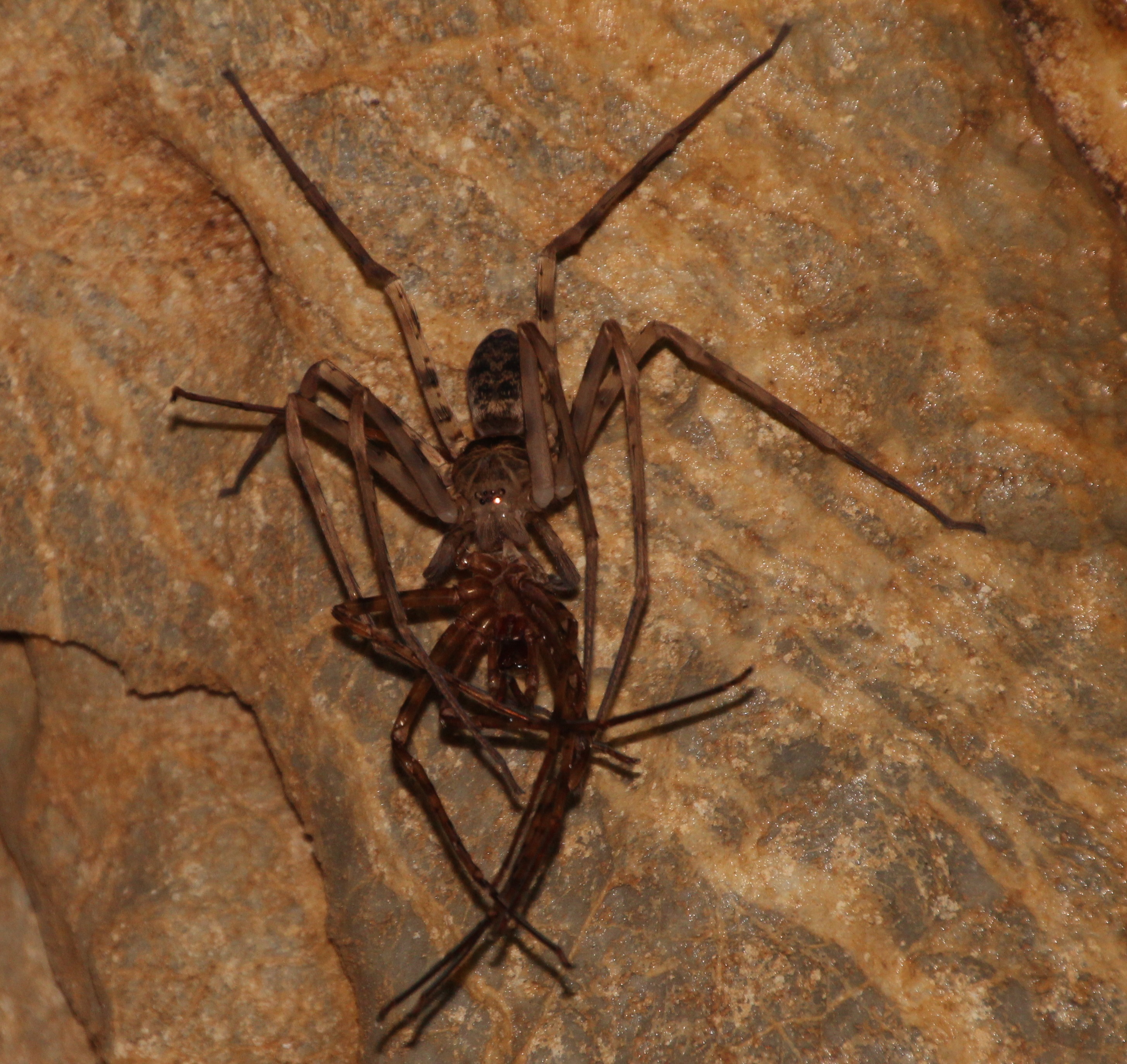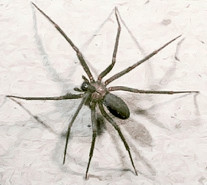|
Sparassidae
Huntsman spiders, members of the family Sparassidae (formerly Heteropodidae), catch their prey by hunting rather than in webs. They are also called giant crab spiders because of their size and appearance. Larger species sometimes are referred to as wood spiders, because of their preference for woody places (forests, mine shafts, woodpiles, wooden shacks). In southern Africa the genus '' Palystes'' are known as rain spiders or lizard-eating spiders. Commonly, they are confused with baboon spiders from the Mygalomorphae infraorder, which are not closely related. More than a thousand Sparassidae species occur in most warm temperate to tropical regions of the world, including much of Australia, Africa, Asia, the Mediterranean Basin, and the Americas. Several species of huntsman spider can use an unusual form of locomotion. The wheel spider (''Carparachne aureoflava'') from the Namib uses a cartwheeling motion which gives it its name, while '' Cebrennus rechenbergi'' uses a hands ... [...More Info...] [...Related Items...] OR: [Wikipedia] [Google] [Baidu] |
Palystes
''Palystes'' is a genus of huntsman spiders, commonly called rain spiders or lizard-eating spiders, occurring in Africa, India, Australia, and the Pacific. The most common and widespread species is '' P. superciliosus'', found in South Africa, home to 12 species in the genus. The name ''Palystes'' is derived from either the Latin ''palaestes'' or the Greek ''palaistes'', meaning "wrestler". The genus was first described by Ludwig Carl Christian Koch in 1875. Build ''Palystes'' species are large spiders, with a body length of 15–36 mm, and a leg span up to 110 mm. Their top side is covered in tan to dark tan velvety setae (hairs). The underside of their legs is banded in colour, and their legs and abdomens may be interspersed with slightly longer setae. They have a large moustachial stripe below their front eyes, and extending down their fangs. Habits While ''Palystes'' species mostly hunt insects on plants, they commonly enter houses before rain, or during the summer ... [...More Info...] [...Related Items...] OR: [Wikipedia] [Google] [Baidu] |
Giant Huntsman Spider
The giant huntsman spider (''Heteropoda maxima'') is a species of the huntsman spider family Sparassidae found in Laos. It is considered the world's largest spider by leg span, which can reach up to . Description The coloration is yellowish-brown with several irregularly distributed dark spots on the rear half. The legs have wide dark bands before the first bend. Like all huntsman spiders, the legs of the giant huntsman spider are long compared to the body, and twist forward in a crab-like fashion. Apart from its size, the ''H. maxima'' can be distinguished from other species of ''Heteropoda'' by genital characteristics. On males, the pedipalp, cymbium is at least three times longer than the tegulum. The female is distinguished by a characteristically shaped epigyneal field with two anterior directed bands, and the course of their internal ducts. The giant huntsman spider is the largest member of the family Sparassidae, boasting a leg-span, and body-length. The largest known ... [...More Info...] [...Related Items...] OR: [Wikipedia] [Google] [Baidu] |
List Of Sparassidae Species
This page lists all described genera and species of the spider family Sparassidae. , the World Spider Catalog accepts 1383 species in 96 genera: * '' † Sparassidae sp.'' Wunderlich, 2008c — Palaeogen Baltic amber A ''Adcatomus'' '' Adcatomus'' Karsch, 1880 - Sparassinae * '' Adcatomus ciudadus'' Karsch, 1880 (type) — Venezuela, Peru * '' Adcatomus flavovittatus'' (Simon, 1897) — Venezuela ''Anaptomecus'' '' Anaptomecus'' Simon, 1903 - Incertae Sedis * '' Anaptomecus levyi'' Jäger, Rheims & Labarque, 2009 — Colombia * '' Anaptomecus longiventris'' Simon, 1903 (type) — Costa Rica, Panama, Ecuador * '' Anaptomecus paru'' Guala, Labarque & Rheims, 2012 — Colombia, Ecuador * '' Anaptomecus suni'' Guala, Labarque & Rheims, 2012 — Ecuador * '' Anaptomecus temii'' Jäger, Rheims & Labarque, 2009 — Panama * '' Anaptomecus yarigui'' Galvis & Rheims, 2018 — Colombia ''Anchonastus'' '' Anchonastus'' Simon, 1898 - Palystinae * '' Anchonastus caudatus'' Simon, 1898 (ty ... [...More Info...] [...Related Items...] OR: [Wikipedia] [Google] [Baidu] |
Palystes Castaneus
''Palystes castaneus'' is a species of huntsman spider found in parts of South Africa. It is common from Cape Town to Heidelberg, Western Cape, especially in forested areas. In scrub outside forested areas, it is replaced by '' Palystes superciliosus''. It occurs mainly on plants, where it hunts insects. It has a body length of 17–22 mm. ''P. castaneus'' is the type species for the genus ''Palystes'', and was first described by Pierre André Latreille in 1819. Spiders in the genus ''Palystes'' are commonly called rain spiders, or lizard-eating spiders. ''P. castaneus'' often appears in the home just before the onset of rain, where they hunt geckos (usually '' Afrogecko porphyreus''). Males are regularly seen from August to December, probably looking for females. After mating in the early summer, the female constructs a round egg sac about 60–100 mm in size made of silk, with twigs and leaves woven into it. These egg sacs are commonly seen from about November to Apr ... [...More Info...] [...Related Items...] OR: [Wikipedia] [Google] [Baidu] |
Neosparassus
''Neosparassus'' is a genus of huntsman spiders found in Australia and first described by Henry Roughton Hogg Henry Roughton Hogg (9 February 1846 – 30 November 1923) was a British amateur arachnologist and businessman who lived in both Australia and Britain. Hogg emigrated to Australia in December 1873 and co-founded a mercantile and shipping agency ... in 1903. Members of this genus most closely resemble those of '' Heteropoda'', except that the cephalothorax is high, peaking between the midpoint and the eyes, before sloping toward the back. This angle causes the front of these spiders to appear more prominent than it actually is. Species it contains the following species: *'' Neosparassus calligaster'' (Thorell, 1870) — Australia *'' Neosparassus conspicuus'' (L. Koch, 1875) — Queensland *'' Neosparassus diana'' (L. Koch, 1875) — Western Australia, Victoria, Tasmania *'' Neosparassus festivus'' (L. Koch, 1875) — New South Wales *'' Neosparassus grapsus'' (Walc ... [...More Info...] [...Related Items...] OR: [Wikipedia] [Google] [Baidu] |
Cebrennus Rechenbergi
''Cebrennus rechenbergi'', also known as the Moroccan flic-flac spider and cartwheeling spider, is a species of huntsman spider indigenous to the sand dunes of the Erg Chebbi desert in Morocco. If provoked or threatened it can escape by doubling its normal walking speed using forward or backward flips similar to acrobatic flic-flac movements used by gymnasts. ''C. rechenbergi'' is the only spider known to use this unique form of rolling locomotion. The discovery of the Moroccan flic-flac spider has influenced biomimetic robot research, resulting in the development of an experimental robot based on the spider's motion.King, R.S. (2013). ''BiLBIQ: A Biologically Inspired Robot with Walking and Rolling Locomotion''. Biosystems and Biorobotics. 2. Springer, Verlag, Berlin, Heidelberg. Etymology The spider is named after its discoverer, Ingo Rechenberg, bionics professor at the Technische Universität Berlin. Rechenberg may have first encountered the spider on a trip to Morocco ... [...More Info...] [...Related Items...] OR: [Wikipedia] [Google] [Baidu] |
Philipp Bertkau
Philipp Bertkau (11 January 1849 – 22 October 1894) was a German zoologist born in Cologne. He studied natural sciences at the University of Bonn, where in 1872 he earned his doctorate. In 1873, he became an assistant at the botanical institute in Munich, and during the following spring was an assistant at the zoological institute at Bonn. In 1882 he was appointed professor at the Agricultural Academy of Poppelsdorf, and in 1890 became curator at the Institute of Zoology and Comparative Anatomy. Bertkau is remembered for his work involving the anatomy and physiology of spiders, research on sense of smell in butterflies, and anatomical studies of hermaphroditic arthropods. At Bonn he was secretary of ''Bonner Gesellschaft für Naturgeschichte'' (Bonn Society of Natural History). He is the taxonomic authority of the families Anyphaenidae, Hahniidae, Sparassidae and Zoropsidae, and of the genera '' Ancylometes'', ''Chalcoscirtus'', '' Comaroma'' and '' Diplocephalus''. Selected ... [...More Info...] [...Related Items...] OR: [Wikipedia] [Google] [Baidu] |
Brown Recluse Spider
The brown recluse (''Loxosceles reclusa'', Sicariidae, formerly placed in a family "Loxoscelidae") is a recluse spider with necrotic venom. Similar to those of other recluse spiders, their bites sometimes require medical attention. The brown recluse is one of two spiders in North America with dangerous venom, the other being the black widow. Brown recluse spiders are usually between , but may grow larger. While typically light to medium brown, they range in color from whitish to dark brown or blackish gray. The cephalothorax and abdomen are not necessarily the same color. These spiders usually have markings on the dorsal side of their cephalothorax, with a black line coming from it that looks like a violin with the neck of the violin pointing to the rear of the spider, resulting in the nicknames fiddleback spider, brown fiddler, or violin spider. Description The violin pattern is not a definitive identifier, as other spiders can have similar markings (e.g. cellar spider ... [...More Info...] [...Related Items...] OR: [Wikipedia] [Google] [Baidu] |
Tarantula
Tarantulas comprise a group of large and often hairy spiders of the family Theraphosidae. , 1,100 species have been identified, with 166 genera. The term "tarantula" is usually used to describe members of the family Theraphosidae, although many other members of the same infraorder ( Mygalomorphae) are commonly referred to as "tarantulas" or "false tarantulas". Some of the more common species have become popular in the exotic pet trade. Many New World species kept as pets have setae known as urticating hairs that can cause irritation to the skin, and in extreme cases, cause damage to the eyes. Overview Like all arthropods, the tarantula is an invertebrate that relies on an exoskeleton for muscular support.Pomeroy, R. (2014, February 4). Pub. Real Clear Science, "Spiders, and Their Amazing Hydraulic Legs and Genitalia". Retrieved October 13, 2019, from https://www.realclearscience.com/blog/2013/02/spiders-their-amazing-hydraulic-legs-and-genitals.html. Like other Arachni ... [...More Info...] [...Related Items...] OR: [Wikipedia] [Google] [Baidu] |
Anatomical Terms Of Location
Standard anatomical terms of location are used to describe unambiguously the anatomy of humans and other animals. The terms, typically derived from Latin or Greek roots, describe something in its standard anatomical position. This position provides a definition of what is at the front ("anterior"), behind ("posterior") and so on. As part of defining and describing terms, the body is described through the use of anatomical planes and axes. The meaning of terms that are used can change depending on whether a vertebrate is a biped or a quadruped, due to the difference in the neuraxis, or if an invertebrate is a non-bilaterian. A non-bilaterian has no anterior or posterior surface for example but can still have a descriptor used such as proximal or distal in relation to a body part that is nearest to, or furthest from its middle. International organisations have determined vocabularies that are often used as standards for subdisciplines of anatomy. For example, '' Termi ... [...More Info...] [...Related Items...] OR: [Wikipedia] [Google] [Baidu] |
Wheel Spider
The wheel spider or golden wheel spider (''Carparachne aureoflava''), is a huntsman spider native to the Namib Desert of Southern Africa. This spider is distinct from '' Leucorchestris arenicola'', a spider sharing the same common name and found in the same locale. The spider escapes parasitic pompilid wasps by flipping onto its side and cartwheeling down sand dune A dune is a landform composed of wind- or water-driven sand. It typically takes the form of a mound, ridge, or hill. An area with dunes is called a dune system or a dune complex. A large dune complex is called a dune field, while broad, flat ...s at speeds of up to 44 turns per second. Characteristics Wheel spiders are up to 20 mm in size, with males and females the same size. The wheel spider does not make a web; it is a nocturnal, free-ranging hunter, coming out at night to prey on insects and other small invertebrates. Its bite is mildly venomous, but the spider is not known to be harmful to humans. ... [...More Info...] [...Related Items...] OR: [Wikipedia] [Google] [Baidu] |
Genera
Genus (; : genera ) is a taxonomic rank above species and below family as used in the biological classification of living and fossil organisms as well as viruses. In binomial nomenclature, the genus name forms the first part of the binomial species name for each species within the genus. :E.g. '' Panthera leo'' (lion) and '' Panthera onca'' (jaguar) are two species within the genus '' Panthera''. ''Panthera'' is a genus within the family Felidae. The composition of a genus is determined by taxonomists. The standards for genus classification are not strictly codified, so different authorities often produce different classifications for genera. There are some general practices used, however, including the idea that a newly defined genus should fulfill these three criteria to be descriptively useful: # monophyly – all descendants of an ancestral taxon are grouped together (i.e. phylogenetic analysis should clearly demonstrate both monophyly and validity as a separate lineag ... [...More Info...] [...Related Items...] OR: [Wikipedia] [Google] [Baidu] |







